Long non-coding RNA urothelial carcinoma associated 1 induces cell replication by inhibiting BRG1 in 5637 cells
- PMID: 24993775
- PMCID: PMC4121403
- DOI: 10.3892/or.2014.3309
Long non-coding RNA urothelial carcinoma associated 1 induces cell replication by inhibiting BRG1 in 5637 cells
Abstract
Long non-coding RNA urothelial carcinoma associated 1 (UCA1) was first identified in bladder cancer tissues. High expression of UCA1 in bladder cancer has suggested it may serve as a potential diagnostic molecular marker for bladder cancer. Subsequent research in bladder cancer cell lines showed that UCA1 can promote cell proliferation, but the underlying mechanism remains unknown. In the present study, we identified BRG1 as a UCA1 binding partner using an in vitro RNA pull-down assay, and RNA-binding protein immunoprecipitation assay confirmed UCA1-BRG binding in bladder cancer cells in vivo. BRG1 is a chromatin remodeling factor with reported tumor suppressor activities that directly upregulates levels of the p21 cell cycle inhibitor by binding sequences in the p21 promoter. Depletion of UCA1 by RNAi resulted in upregulated p21 levels and inhibition of cell replication, while overexpressed UCA1 reduced p21 protein and promoted cell growth. Notably, UCA1 downregulation of p21 and induction of cell proliferation antagonized the function of BRG1. UCA1 highly expressed tissue samples are often with BRG1 high expression. Furthermore, we found that UCA1 impairs both binding of BRG1 to the p21 promoter and chromatin remodeling activity of BRG1. Collectively, these results demonstrate that UCA1 promotes bladder cancer cell proliferation by inhibiting BRG1.
Figures
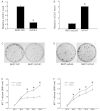
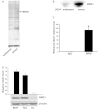
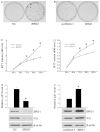
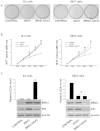

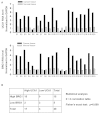
Similar articles
-
Urothelial carcinoma associated 1 is a hypoxia-inducible factor-1α-targeted long noncoding RNA that enhances hypoxic bladder cancer cell proliferation, migration, and invasion.Tumour Biol. 2014 Jul;35(7):6901-12. doi: 10.1007/s13277-014-1925-x. Epub 2014 Apr 16. Tumour Biol. 2014. PMID: 24737584
-
Upregulation of long non-coding RNA urothelial carcinoma associated 1 by CCAAT/enhancer binding protein α contributes to bladder cancer cell growth and reduced apoptosis.Oncol Rep. 2014 May;31(5):1993-2000. doi: 10.3892/or.2014.3092. Epub 2014 Mar 19. Oncol Rep. 2014. PMID: 24648007 Free PMC article.
-
Inhibition of long non-coding RNA UCA1 by CRISPR/Cas9 attenuated malignant phenotypes of bladder cancer.Oncotarget. 2017 Feb 7;8(6):9634-9646. doi: 10.18632/oncotarget.14176. Oncotarget. 2017. PMID: 28038452 Free PMC article.
-
Long Non-Coding RNA Urothelial Carcinoma Associated 1 (UCA1): Insight into Its Role in Human Diseases.Crit Rev Eukaryot Gene Expr. 2015;25(3):191-7. doi: 10.1615/critreveukaryotgeneexpr.2015013770. Crit Rev Eukaryot Gene Expr. 2015. PMID: 26558942 Review.
-
Involvement of the chromatin-remodeling factor BRG1/SMARCA4 in human cancer.Epigenetics. 2008 Mar-Apr;3(2):64-8. doi: 10.4161/epi.3.2.6153. Epub 2008 Apr 17. Epigenetics. 2008. PMID: 18437052 Review.
Cited by
-
Diagnostic value of the UCA1 test for bladder cancer detection: a clinical study.Springerplus. 2015 Jul 16;4:349. doi: 10.1186/s40064-015-1092-6. eCollection 2015. Springerplus. 2015. PMID: 26191476 Free PMC article.
-
The Role of BRG1 in Antioxidant and Redox Signaling.Oxid Med Cell Longev. 2020 Sep 14;2020:6095673. doi: 10.1155/2020/6095673. eCollection 2020. Oxid Med Cell Longev. 2020. PMID: 33014273 Free PMC article. Review.
-
PBRM1 bromodomains associate with RNA to facilitate chromatin association.Nucleic Acids Res. 2023 May 8;51(8):3631-3649. doi: 10.1093/nar/gkad072. Nucleic Acids Res. 2023. PMID: 36808431 Free PMC article.
-
Genistein Represses HOTAIR/Chromatin Remodeling Pathways to Suppress Kidney Cancer.Cell Physiol Biochem. 2020 Jan 22;54(1):53-70. doi: 10.33594/000000205. Cell Physiol Biochem. 2020. PMID: 31961100 Free PMC article.
-
Understanding the Role of Non-Coding RNAs in Bladder Cancer: From Dark Matter to Valuable Therapeutic Targets.Int J Mol Sci. 2017 Jul 13;18(7):1514. doi: 10.3390/ijms18071514. Int J Mol Sci. 2017. PMID: 28703782 Free PMC article. Review.
References
Publication types
MeSH terms
Substances
LinkOut - more resources
Full Text Sources
Other Literature Sources
Medical
Miscellaneous

